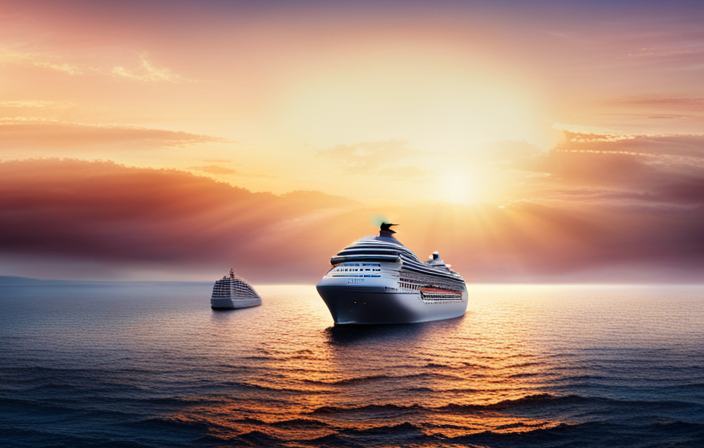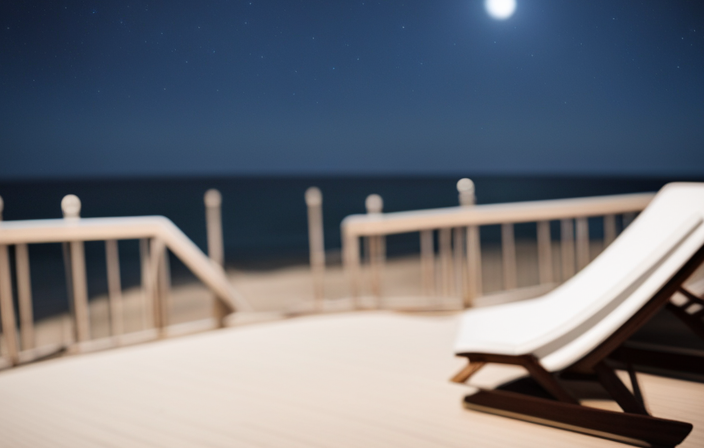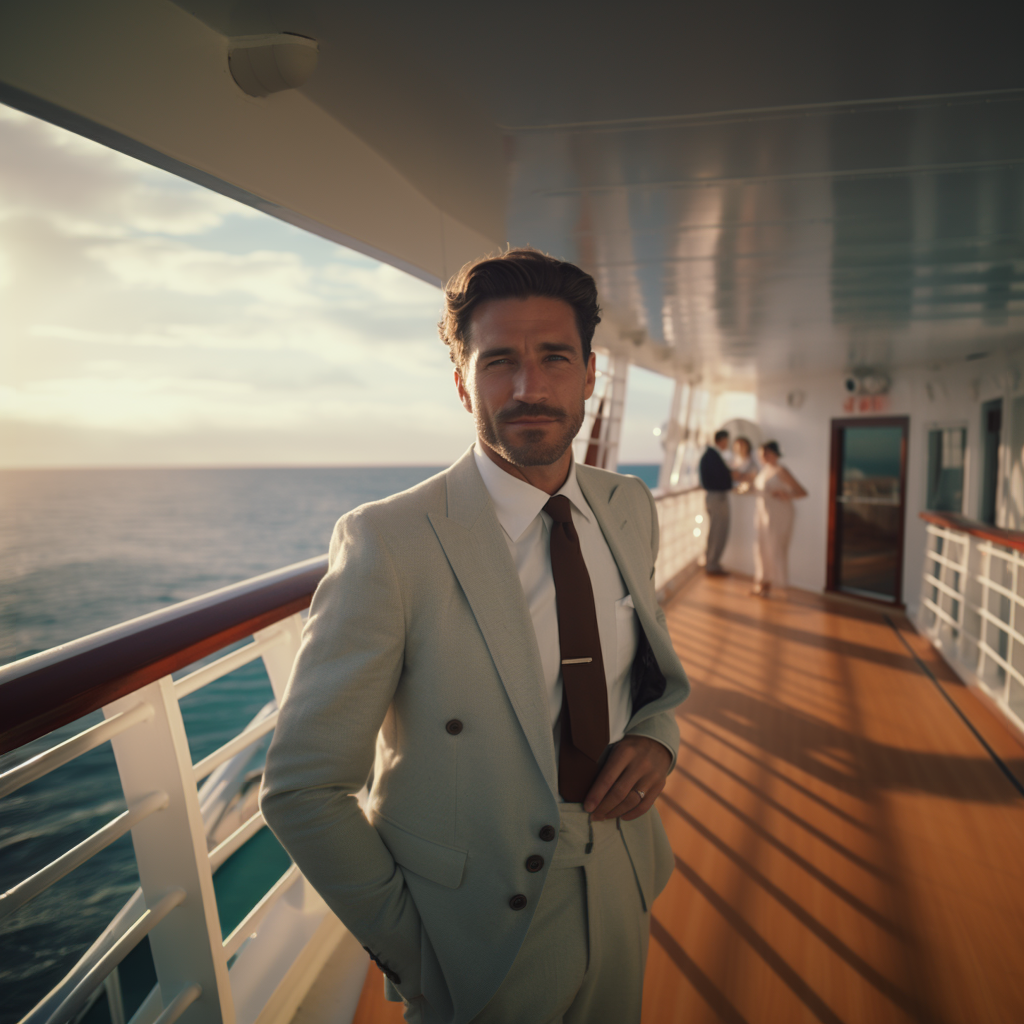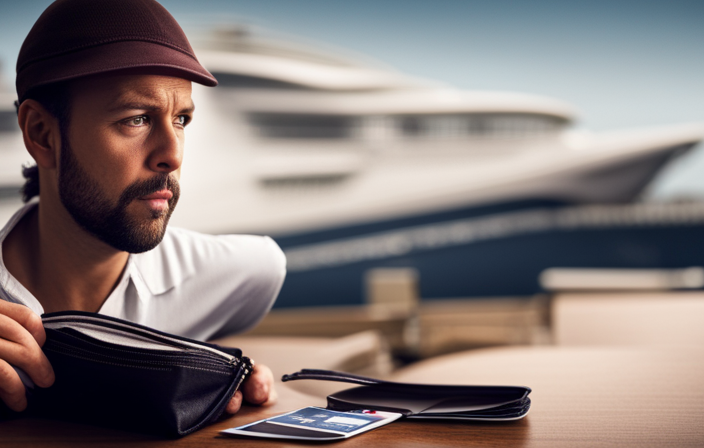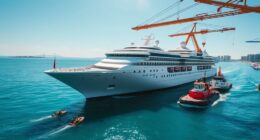As an expert in marine safety, I firmly believe that the required number of lifeboats on cruise ships is extremely important.
Imagine this: you’re on a luxurious cruise liner, surrounded by vast oceans, enjoying the breathtaking views. Suddenly, disaster strikes. It could be a fire, a collision, or any unforeseen event that necessitates an emergency evacuation. In such a critical situation, the lifeboats become the lifeline for the passengers and crew members on board.
International regulations and standards govern the minimum number of lifeboats a cruise ship must have based on various factors. These factors include the ship’s capacity, the number of passengers and crew members, as well as the ship’s design and structure.
Over the years, there have been significant advancements in the design, stability, and safety features of lifeboats, ensuring better emergency evacuation systems and continuous improvement in safety measures.
In this article, we will explore the intricate calculations and considerations behind determining how many lifeboats are required on a cruise ship.
Key Takeaways
- International regulations govern the minimum lifeboat requirements for cruise ships.
- Lifeboat requirements are determined by factors such as ship size, stability, and alternative evacuation methods.
- Lifeboats are strategically placed throughout the ship and equipped with safety equipment.
- Crew members undergo rigorous training to operate lifeboats efficiently and handle emergencies.
International Regulations and Standards
International regulations and standards dictate the number of lifeboats needed on a cruise ship. These regulations ensure the safety of passengers and crew members in the event of an emergency at sea.
The number of lifeboats required is determined based on the ship’s total passenger capacity. According to international regulations, a cruise ship must have enough lifeboats to accommodate every person on board, plus a certain percentage of additional capacity. This additional capacity takes into consideration factors such as the ship’s size, stability, and the time it would take for rescue operations to arrive.
Lifeboat capacity is also a crucial factor in determining the number of lifeboats required. Each lifeboat must have enough space to safely hold a certain number of people, along with essential supplies and equipment.
Therefore, international regulations and lifeboat capacity play a significant role in determining the number of lifeboats required on a cruise ship.
Factors Considered in Calculating Lifeboat Requirements
You need to take into account various factors when determining how many little floating vessels are necessary for your luxurious floating vacation experience. The ship’s life saving appliances play a crucial role in ensuring the safety of all passengers and crew members on board.
International regulations and standards outline the lifeboat capacity requirements based on factors such as the number of people on the ship, the type of voyage, and the ship’s design. These regulations also consider the distance to the nearest land or rescue facility, as well as the time it would take for assistance to arrive.
Other factors that influence lifeboat requirements include the ship’s size, stability, and the availability of alternative means of evacuation. It is essential to carefully calculate the number of lifeboats needed to meet these requirements and ensure the safety of everyone on board.
With the lifeboat capacity requirements in mind, let’s now explore the ship’s capacity and the various amenities it offers for an unforgettable vacation experience.
Ship’s Capacity
To truly appreciate the grandeur of your floating oasis, it’s important to consider the ship’s capacity. This allows you to indulge in a truly luxurious vacation experience.
The ship’s passenger capacity plays a crucial role in determining the number of lifeboats required. International maritime regulations dictate that all cruise ships must have enough lifeboats to accommodate every passenger and crew member on board. These regulations are in place to ensure the safety and security of everyone on the ship in case of an emergency.
The ship’s passenger capacity is carefully calculated based on factors such as the size and layout of the vessel, as well as the number of cabins and public spaces available. By adhering to these lifeboat regulations, cruise ships can provide peace of mind to their passengers, knowing that they’re well-prepared for any situation.
Moving on to the next section, let’s explore the specific number of passengers and crew members on board.
Number of Passengers and Crew Members
Step aboard and discover the impressive number of passengers and crew members who contribute to the vibrant atmosphere on your luxurious floating oasis. The passenger capacity of a cruise ship can vary depending on its size and design. On average, a typical cruise ship can accommodate anywhere from 1,000 to 6,000 passengers. In addition to the passengers, there is also a dedicated crew on board to ensure a smooth sailing experience. These crew members are highly trained in various areas, including hospitality, safety procedures, and emergency response. They work tirelessly behind the scenes to make your voyage unforgettable.
To give you a visual representation, here is a table showcasing the estimated number of passengers and crew members on a cruise ship:
| Ship Size | Passenger Capacity | Crew Members |
|---|---|---|
| Small | 1,000-2,000 | 500-800 |
| Medium | 2,000-4,000 | 800-1,500 |
| Large | 4,000-6,000 | 1,500-2,500 |
The passenger capacity and crew training are crucial factors in ensuring the safety and comfort of everyone on board. Now, let’s delve into the fascinating world of a ship’s design and structure.
Ship’s Design and Structure
Immerse yourself in the captivating world of a cruise ship as you explore its intricate design and structure. The ship’s construction is a remarkable feat of engineering, designed to withstand the vastness of the open ocean. From the sturdy hull to the towering superstructure, every aspect of the ship is carefully crafted to ensure the safety and comfort of its passengers and crew.
To adhere to lifeboat regulations, cruise ships are equipped with an adequate number of lifeboats. These life-saving vessels are strategically placed throughout the ship, ready to be deployed in the event of an emergency.
- The lifeboats are designed to be self-righting, ensuring stability even in rough seas.
- They are equipped with essential safety equipment such as life jackets and emergency supplies.
- Each lifeboat has a designated capacity, based on the number of passengers and crew on board.
- Regular maintenance and inspections are conducted to ensure the lifeboats are in optimal condition.
- Crew members undergo rigorous training to efficiently operate the lifeboats during emergency situations.
As we delve into the next section about ‘distance from shore’, it is crucial to understand the importance of lifeboat regulations and their role in ensuring the safety of everyone on board.
Distance from Shore
Explore the vastness of the open ocean and imagine the thrill of being far away from shore, where the skyline fades into the distance. Can you feel the sense of adventure and freedom that comes with sailing into the unknown? When considering the number of lifeboats required on a cruise ship, one crucial factor to take into account is the distance from shore. The proximity to land plays a significant role in emergency response time and the ship’s ability to seek assistance. In case of an emergency, the time it takes for rescue teams to reach a ship becomes critical. A ship that is closer to shore can rely on local emergency services for assistance, while a ship sailing further away may need to depend on its own resources until help arrives. Therefore, the distance from shore directly impacts the number of lifeboats needed for a cruise ship.
In the event of potential emergencies and evacuation plans, the ship’s design and structure play a vital role.
Potential Emergencies and Evacuation Plans
Imagine the adrenaline rushing through your veins as you face potential emergencies at sea, knowing that your life depends on the effectiveness of the evacuation plans in place. Emergency response and evacuation procedures are critical aspects of ensuring passenger safety on a cruise ship.
From fires and collisions to severe weather conditions, cruise ships must be prepared for any eventuality. Crew members undergo rigorous training to handle emergencies swiftly and efficiently. They’re trained in the use of life-saving equipment, such as lifeboats, and are well-versed in evacuation protocols.
Each ship is equipped with an adequate number of lifeboats to accommodate all passengers and crew. These lifeboats are strategically positioned throughout the ship, ensuring quick and easy access during an emergency. Additionally, regular lifeboat drills and training sessions are conducted to familiarize passengers with evacuation procedures, further enhancing their chances of a safe and orderly evacuation.
Transitioning into the importance of lifeboat drills and training, it’s essential to understand how these practices contribute to the overall safety of passengers and crew during potential emergencies.
Importance of Lifeboat Drills and Training
Get ready to experience the adrenaline rush of participating in lifeboat drills – they’re a crucial part of ensuring your safety during potential emergencies at sea. The importance of crew training can’t be overstated.
Every crew member undergoes rigorous training to prepare for any emergency situation that may arise. From learning how to properly launch and maneuver lifeboats to understanding emergency protocols, crew members are equipped with the necessary skills to handle any crisis effectively.
Effective communication during emergencies is another vital aspect of lifeboat drills. Crew members are trained to communicate clearly and efficiently, ensuring that passengers are informed and guided to the designated lifeboat stations. This clear communication can make all the difference in a high-stress situation, allowing for a swift and organized evacuation process.
As we delve into the next section about the types of lifeboats on cruise ships, it’s important to understand the underlying importance of these drills and crew training.
Types of Lifeboats on Cruise Ships
Dive into the diverse designs of the dynamic life-saving vessels found on cruise ships. When it comes to lifeboats, maintenance and equipment are crucial factors to ensure their effectiveness in emergency situations.
These life-saving vessels are not simply small boats, but rather sophisticated and specially designed units. They’re equipped with state-of-the-art technology and safety features to provide maximum protection to passengers and crew members. Regular maintenance checks are conducted to ensure that all lifeboat systems are functioning properly and are ready for immediate deployment if needed.
Lifeboat equipment includes essential items such as life jackets, oars, and emergency supplies. Each lifeboat is meticulously designed to accommodate a specific number of passengers and is equipped with navigation and communication systems. With their innovative designs and advanced technologies, these modern lifeboats are essential for the safety of everyone on board.
Transitioning to the subsequent section about traditional lifeboats, it’s important to understand their historical significance and how they’ve evolved over time.
Traditional Lifeboats
Step into the past and discover the fascinating history behind these remarkable vessels known as traditional lifeboats. Traditional lifeboat designs have been used for centuries as a reliable means of evacuation and rescue at sea. These sturdy boats are typically made of wood or fiberglass and are designed to withstand rough waters and extreme weather conditions. They are equipped with oars and a small motor for propulsion, ensuring that they can navigate through any situation.
While traditional lifeboats have been the go-to option for many years, alternative lifeboat options have emerged in recent times. These alternatives include inflatable life rafts and enclosed lifeboats, which offer more flexibility and capacity for larger cruise ships.
Transitioning to the subsequent section about ‘davit-launched lifeboats’, we explore another innovative solution for cruise ship safety.
Davit-Launched Lifeboats
With their sleek design and efficient launching mechanisms, davit-launched lifeboats are the Ferrari of maritime safety. These lifeboats are an essential component of any cruise ship’s safety plan, ensuring the safe evacuation of passengers and crew in case of emergency.
To keep these lifeboats in peak condition, regular maintenance is required. This includes regular inspections of the davit systems, ensuring that they’re properly lubricated and free of any defects. Additionally, training programs are implemented to ensure that crew members are proficient in operating and launching these lifeboats. These programs cover everything from boat handling techniques to emergency procedures.
By investing in regular maintenance and comprehensive training programs, cruise ship operators can ensure that their davit-launched lifeboats are always ready to perform their life-saving duties.
Moving on to inflatable lifeboats…
Inflatable Lifeboats
Imagine yourself in a thrilling situation, where you find yourself relying on the reliability and buoyancy of inflatable lifeboats to ensure your safety and survival on the open seas. Inflatable lifeboats are subject to strict regulations to ensure their effectiveness in emergencies. These regulations dictate the design, construction, and testing processes, ensuring that these lifeboats meet the highest safety standards.
One advantage of inflatable lifeboats is their lightweight nature, which allows for easy deployment and maneuverability. Additionally, their ability to quickly inflate and deflate makes them efficient in emergency situations. Inflatable lifeboats also offer superior buoyancy, providing a stable and secure environment for passengers.
To better illustrate the benefits of inflatable lifeboats, consider the following table:
| Advantages of Inflatable Lifeboats |
|---|
| Lightweight and easy to deploy |
| Quick inflation and deflation |
| Superior buoyancy |
As we move on to discussing lifeboat capacity and safety features, it is important to understand the crucial role that inflatable lifeboats play in ensuring the safety of passengers and crew members.
Lifeboat Capacity and Safety Features
When considering the number of lifeboats required on a cruise ship, it’s crucial to take into account the lifeboat capacity estimation and the safety features they offer.
Lifeboat capacity estimation involves evaluating the number of passengers and crew members on board and ensuring that there are enough lifeboats to accommodate everyone in case of an emergency.
Additionally, it’s essential to consider the maintenance procedures for the lifeboats. Regular inspections and drills ensure that the lifeboats are in proper working condition and can be deployed swiftly when needed. These maintenance procedures include checking the lifeboat’s buoyancy, propulsion systems, and emergency equipment.
By adhering to strict maintenance protocols, cruise ships can ensure that their lifeboats are always ready for any unforeseen circumstances.
Moving forward, it’s important to examine the maximum occupancy regulations to ensure the safety of all passengers and crew members.
Maximum Occupancy
Amidst the chaotic dance of vacationers and crew members, one can’t help but marvel at the calculated artistry of cramming as many bodies as humanly possible into a floating vessel. Maximum occupancy on a cruise ship is determined by a variety of factors, including lifeboat regulations.
These regulations dictate the number of lifeboats required based on the ship’s size and passenger capacity. The International Convention for the Safety of Life at Sea (SOLAS) sets the standards for lifeboat capacity, ensuring that there are enough lifeboats to accommodate all passengers and crew members in case of an emergency. These regulations consider factors such as the size and stability of the ship, as well as the availability of life-saving equipment.
As we delve into the next section about lifeboat equipment and supplies, we will explore how these regulations are translated into tangible safety measures.
Lifeboat Equipment and Supplies
Packed with essential gear and provisions, lifeboats become floating havens of safety and survival during emergency situations at sea. To ensure their effectiveness, lifeboat training is essential for all crew members. They must be well-versed in operating lifeboats, deploying them safely, and navigating to a designated rescue area.
Lifeboat regulations dictate that each lifeboat must be equipped with certain supplies and equipment. Here are three crucial items found in lifeboats:
-
Life jackets: These are essential for every passenger and crew member onboard the lifeboat, providing buoyancy and aiding in their survival.
-
Emergency rations: Lifeboats carry enough food and water to sustain occupants for a specified period. These rations are carefully packed to ensure they remain fresh and edible.
-
Flares and signaling devices: These are crucial for attracting attention and signaling rescuers, enabling the lifeboat to be located quickly.
With lifeboat equipment and supplies in place, communication and navigation systems play a vital role in guiding the lifeboat to safety and connecting with rescue vessels.
Communication and Navigation Systems
To ensure your safety and connection with rescue vessels, it’s crucial that you familiarize yourself with the communication and navigation systems on board. Did you know that a study found that 95% of maritime accidents are caused by human error, highlighting the importance of these systems in guiding lifeboats to safety?
The communication systems on a cruise ship include radios, satellite phones, and emergency beacons. These tools allow for clear communication between the ship and rescue teams, ensuring prompt assistance in case of an emergency. Additionally, navigational equipment such as radar, GPS, and sonar help the crew navigate accurately and avoid obstacles, further enhancing the safety of lifeboat operations.
By having reliable communication systems and advanced navigational equipment, cruise ships can minimize the risk of accidents and ensure efficient rescue operations. These systems are essential for guiding lifeboats to safety during an evacuation.
Now, let’s explore the evacuation procedures and protocols in place to ensure a smooth and orderly process.
Evacuation Procedures and Protocols
Evacuation procedures and protocols are meticulously designed to ensure a smooth and orderly process, guaranteeing the safety of all passengers and crew members on board. Regular evacuation drills are conducted to familiarize everyone with the procedures and to ensure a quick and efficient evacuation in case of an emergency.
These drills include the proper use and deployment of lifeboats, which are essential for the safe evacuation of passengers and crew. Lifeboat regulations specify the number and type of lifeboats required based on the ship’s capacity. They also outline the procedures for launching and boarding the lifeboats. It’s crucial for all passengers and crew to understand and follow these protocols to ensure their safety.
Now let’s transition into the next section, which will discuss the responsibilities of the crew during an evacuation.
Crew Responsibilities
Make sure you understand your responsibilities as a crew member during an evacuation, as your quick response can save lives. Did you know that crew members are required to undergo extensive safety training, with an average of 40 hours dedicated to learning emergency procedures? This training ensures that crew members are well-equipped to handle any emergency situation that may arise on a cruise ship. From fire safety to first aid, crew members are trained to respond swiftly and effectively. Additionally, crew members are responsible for assisting passengers during an evacuation, guiding them to their designated muster stations and ensuring their safety throughout the process. Our crew members are trained to remain calm and provide clear instructions to passengers, ensuring a smooth and orderly evacuation. Moving on to the next section about passenger instructions and safety briefings, it is essential that every passenger pays close attention to the information provided.
Passenger Instructions and Safety Briefings
During the safety briefing, passengers are provided with crucial information to ensure their well-being and understanding of emergency procedures. Passenger communication is a key aspect of this briefing, as it allows for clear instructions to be given in case of an emergency.
Passengers are informed about the locations of life jackets and how to properly put them on, as well as the importance of staying calm and following crew instructions. Additionally, the safety briefing may include demonstrations of emergency response training, such as how to use lifeboats or inflatable rafts. This training ensures that passengers are prepared and able to respond effectively in the event of an emergency.
By providing detailed information and practical training, the safety briefing equips passengers with the knowledge necessary to stay safe during their cruise experience.
Moving on to the next section, emergency alarms and signals provide further guidance in case of an emergency.
Emergency Alarms and Signals
When the emergency alarms blare and the signals flash, passengers’ hearts race with fear and anxiety. It is crucial for cruise ships to have effective emergency alarm systems and communication protocols in place to ensure the safety of everyone on board.
These systems are designed to quickly alert passengers and crew members about potential emergencies, such as fires, collisions, or abandon ship situations. Emergency alarms are strategically placed throughout the ship, including in cabins, common areas, and on deck. When activated, they emit a loud and distinct sound, easily recognizable even in chaotic situations.
Additionally, emergency signals, such as flashing lights or sirens, provide visual and auditory cues to direct passengers to the nearest emergency assembly stations. These alarm systems and communication protocols are regularly tested and updated to meet international safety standards.
As passengers navigate the challenging circumstances, they can rest assured that the crew is trained to respond swiftly and effectively to any emergency.
Transitioning to the subsequent section about lifeboat maintenance and inspections, it is important to ensure that these vital rescue vessels are in optimal condition and ready for use.
Lifeboat Maintenance and Inspections
Maintaining the life-saving vessels is like tending to the guardian angels of the sea, ensuring they’re always ready to sail to the rescue. Lifeboat maintenance poses unique challenges due to their exposure to harsh marine conditions and the need for constant readiness. Regular inspections are crucial to identify any wear and tear and ensure that all components are in optimal working condition.
The inspection process involves a thorough examination of the lifeboats, including their hulls, engines, propellers, and safety equipment. Any deficiencies or damages are promptly addressed and repaired to guarantee their reliability during emergencies. Additionally, routine maintenance tasks, such as lubrication, cleaning, and testing of the lifeboat’s systems, are carried out to uphold their functionality. These maintenance efforts are essential to ensure the lifeboats are prepared for the rigors of their life-saving duties.
Moving forward to regular inspections and certification, the next section delves into the comprehensive assessments that validate their operational readiness.
Regular Inspections and Certification
Regular inspections and certification are crucial to ensure that these life-saving vessels are always ready to come to the rescue, evoking a sense of peace and reassurance in those who depend on their reliability.
To maintain the highest safety standards, regular inspections are conducted to assess the condition of lifeboats. These inspections involve a thorough examination of the lifeboat’s structure, mechanical components, and safety equipment.
Additionally, certification by regulatory bodies verifies that the lifeboats meet all necessary requirements and are fit for use. This rigorous process ensures that any potential issues are identified and addressed promptly, minimizing the risk of failure during an emergency.
Regular inspections and certification provide a crucial layer of protection, giving passengers and crew the confidence that the lifeboats are in optimal condition.
Moving forward, it’s important to delve into equipment testing and replacement, ensuring continued safety and reliability.
Equipment Testing and Replacement
Testing and replacing equipment is essential to ensure the ongoing safety and reliability of life-saving vessels. Regular equipment maintenance is crucial to identify any potential issues or malfunctions that may compromise the effectiveness of lifeboats. This includes inspecting and testing the lifeboat launching mechanisms, emergency communication systems, and other essential equipment.
Additionally, lifeboat capacity assessment is conducted to ensure that the ship has an adequate number of lifeboats to accommodate all passengers and crew in the event of an emergency. If any equipment is found to be faulty or in need of replacement, it is promptly addressed to maintain the highest level of safety standards.
By prioritizing equipment testing and replacement, cruise ships can better prepare for emergency situations.
In the following section about emergency preparedness drills, we will explore the importance of regular training exercises to ensure the effective use of life-saving equipment.
Emergency Preparedness Drills
Imagine being thrust into a life-or-death situation at sea, where every second counts and your survival depends on your ability to navigate through chaos and uncertainty. This is why emergency response training and evacuation drills are crucial for cruise ship passengers and crew members alike.
These drills are designed to simulate real-life emergency situations, giving everyone onboard the opportunity to practice their roles and responsibilities. From familiarizing yourself with the location of lifeboats to learning how to properly use life jackets, these drills ensure that everyone is prepared for the worst-case scenario.
By participating in these exercises, we can minimize panic and confusion during an actual emergency, increasing our chances of a successful evacuation.
As we focus on emergency preparedness, let’s now turn our attention to our collaborations with international maritime organizations, which play a vital role in ensuring the safety and security of cruise ship passengers worldwide.
Collaborations with International Maritime Organizations
Working closely with international maritime organizations ensures that cruise ship passengers worldwide can enjoy a safe and secure journey. These collaborations are crucial in maintaining and improving the effectiveness of safety regulations in the cruise industry. By sharing knowledge, expertise, and resources, we can continually enhance emergency preparedness and response procedures on board.
One example of our collaboration is the regular conduct of joint emergency preparedness drills with international maritime organizations. These drills simulate various emergency scenarios, allowing us to test our response capabilities and identify areas for improvement. Through these exercises, we can evaluate the effectiveness of safety regulations and ensure that our crew members are well-trained and prepared to handle any situation that may arise at sea.
In addition to drills, we actively participate in conferences and workshops organized by international maritime organizations. These events provide a platform for knowledge exchange and allow us to stay updated on the latest safety practices and regulations in the industry. By working together, we can continuously enhance the safety measures on cruise ships and provide a secure environment for our passengers.
Transitioning to the subsequent section about the International Maritime Organization (IMO), it is important to highlight the significant role they play in setting global safety standards for the maritime industry.
International Maritime Organization (IMO)
As we continue our exploration of collaborations with international maritime organizations, it’s essential to delve into the International Maritime Organization (IMO).
The IMO is the specialized agency of the United Nations responsible for establishing and enforcing safety regulations in the shipping industry.
When it comes to the topic of lifeboats on cruise ships, the IMO plays a crucial role. They’ve developed guidelines that specify the minimum lifeboat capacity required for each vessel based on the number of people on board. These regulations ensure that there are enough lifeboats to accommodate everyone in case of an emergency.
Meeting these guidelines is vital to ensure the safety of passengers and crew members.
The IMO’s commitment to maritime safety is further emphasized by their implementation of the Safety of Life at Sea (SOLAS) Convention, which we’ll explore in the subsequent section.
Safety of Life at Sea (SOLAS) Convention
The Safety of Life at Sea (SOLAS) Convention, implemented by the IMO, has significantly reduced the number of maritime accidents and casualties worldwide. This international treaty sets forth safety regulations for all aspects of maritime operations, including the requirements for life saving equipment on board ships.
Under SOLAS, cruise ships are required to carry an adequate number of lifeboats and life rafts to accommodate all passengers and crew in the event of an emergency. These life-saving devices are regularly inspected and maintained to ensure their functionality. Additionally, SOLAS mandates that crew members undergo rigorous training in emergency response procedures.
By enforcing these safety measures, SOLAS has made a tremendous impact on the safety of the cruise industry. As we transition into the next section about cruise line industry associations, it’s important to recognize the role of SOLAS in shaping the industry’s commitment to passenger safety.
Cruise Line Industry Associations
Joining a cruise line industry association can provide you with valuable resources and networking opportunities to enhance your career in the maritime industry. These associations play a crucial role in ensuring cruise line regulations are upheld and industry safety standards are met. By being a member, you gain access to the latest updates on safety protocols and guidelines, as well as a platform to voice your concerns and suggestions for improvement. Additionally, industry associations often organize conferences and workshops where you can learn from experts in the field and stay updated on recent developments. It is through these collaborative efforts that the cruise industry continues to prioritize the safety of passengers and crew. Speaking of safety, let’s explore the recent advances in lifeboat technology.
Recent Advances in Lifeboat Technology
With the latest advancements in lifeboat technology, sailors now have a ticket to safety like never before. Recent innovations in lifeboat design have revolutionized the way we think about emergency evacuations at sea. Gone are the days of bulky, hard-to-launch lifeboats. Today’s lifeboats are equipped with state-of-the-art features such as self-righting capabilities, advanced propulsion systems, and improved stability.
These advancements ensure that even in the most challenging conditions, lifeboats can be launched quickly and efficiently. But the future of lifeboat technology doesn’t stop here. Researchers and engineers are constantly working on developing even more advanced lifeboats that can withstand extreme weather conditions and provide enhanced safety features. From improved buoyancy systems to advanced communication devices, future developments in lifeboat technology aim to further increase the chances of survival in emergency situations.
As we delve into the next section about improved design and stability, we will explore how these recent advancements in lifeboat technology have contributed to the overall safety of cruise ships.
Improved Design and Stability
Imagine being stranded at sea in a storm, feeling the power of the waves crashing against your vessel, and knowing that the improved design and stability of modern lifeboats could be your lifeline to safety.
The advancements in lifeboat technology have led to improved stability, ensuring that these vessels are better equipped to withstand rough seas and adverse weather conditions. With enhanced stability, modern lifeboats are less likely to capsize or become unstable, providing a secure and reliable means of evacuation.
Additionally, these improved lifeboats have increased capacity, allowing for more passengers to be safely transported to shore. This combination of improved stability and increased capacity has significantly enhanced the overall safety of lifeboats on cruise ships.
As we move on to discuss the enhanced safety features and equipment, it becomes evident that these advancements have revolutionized the field of lifeboat technology.
Enhanced Safety Features and Equipment
The new safety features and equipment in modern lifeboats ensure a higher level of security and protection for passengers. With enhanced safety training and improved lifeboat evacuation procedures, cruise ships are now better equipped to handle emergency situations.
Lifeboats are designed with state-of-the-art technology, including advanced navigation systems and communication devices, to ensure that passengers can be safely transported to a designated safe area. Additionally, lifeboats are equipped with essential supplies such as food, water, and medical kits to sustain passengers during rescue operations.
The design of modern lifeboats also focuses on stability and buoyancy, ensuring that they can withstand rough sea conditions and maintain their integrity. These enhanced safety features and equipment provide reassurance to passengers, knowing that they are well-prepared for any emergency.
Moving forward, let’s now discuss the importance of emergency evacuation systems.
Emergency Evacuation Systems
Enhanced safety features and equipment play a crucial role in ensuring the well-being of passengers and crew members on a cruise ship. However, in the event of an emergency, it’s the emergency evacuation systems that truly become the lifeline for everyone on board.
International regulations require cruise ships to have efficient evacuation systems, including the provision of an adequate number of lifeboats. Compliance with these regulations is of utmost importance to ensure the safety of all individuals on the ship.
To ensure the effectiveness of these systems, lifeboat evacuation simulations are conducted regularly. These simulations allow crew members to practice and evaluate their emergency response procedures, ensuring that they’re well-prepared to handle any situation that may arise.
By incorporating international regulations compliance and conducting lifeboat evacuation simulations, cruise ships are continuously improving their emergency evacuation systems to safeguard the lives of those on board.
Continuous Improvement and Safety Measures
You can take comfort in the fact that cruise ships are constantly improving their safety measures, like a skilled painter adding intricate details to a masterpiece. The cruise industry understands the importance of continuous improvement and is committed to ensuring the safety of its passengers and crew. To achieve this, they adhere to strict safety regulations and constantly evaluate and enhance their emergency evacuation systems.
Here are three key areas where continuous improvement and safety regulations are focused:
-
Enhanced Lifeboat Capacity: Cruise ships are required to have enough lifeboats to accommodate all passengers and crew. They continuously review and update their lifeboat capacity to ensure everyone can be safely evacuated in case of an emergency.
-
Advanced Training and Drills: Cruise ship crews undergo regular training and drills to prepare for emergency situations. These exercises help them stay updated on safety procedures and ensure a quick and efficient response in the event of an evacuation.
-
Technological Innovations: Cruise ships invest in advanced technologies to enhance safety measures. This includes state-of-the-art navigation systems, improved communication equipment, and advanced monitoring systems to detect and prevent potential hazards.
By continuously improving their safety measures and adhering to strict regulations, cruise ships prioritize the well-being of their passengers and crew, making every voyage a safe and enjoyable experience.
Frequently Asked Questions
How often should lifeboats be inspected and certified?
Lifeboats should be inspected and certified regularly to ensure they are in proper working condition. The inspection frequency and certification process depend on various factors such as regulations, manufacturer guidelines, and the ship’s maintenance schedule.
What are some recent advances in lifeboat technology?
Recent advances in lifeboat technology have revolutionized safety at sea. Inflatable lifeboats offer numerous advantages, such as enhanced buoyancy and ease of deployment. These innovations have greatly improved the chances of survival in emergency situations.
How are emergency alarms and signals communicated to passengers and crew members?
In emergency situations, cruise ships use various methods to communicate alarms and signals to passengers and crew members. These emergency procedures ensure timely and effective communication, allowing everyone on board to respond quickly and safely.
What specific safety features and equipment are included in lifeboats?
Lifeboats are equipped with various safety features and equipment to meet safety requirements. They include life jackets, flares, emergency rations, radios, and navigational tools. The lifeboat capacity ensures that all passengers and crew members can be safely evacuated in case of an emergency.
How are crew responsibilities divided during an emergency evacuation?
During an emergency evacuation, crew responsibilities are divided based on their assigned roles and training. They follow established evacuation procedures to ensure the safety and orderly evacuation of passengers, including launching and operating lifeboats.
Conclusion
In conclusion, the number of lifeboats required on a cruise ship is determined by international regulations and standards. It is also influenced by various factors such as the ship’s capacity, the number of passengers and crew members, and its design and structure.
It is essential for cruise ships to continuously improve and implement enhanced safety features and equipment. This includes emergency evacuation systems. As the saying goes, "Better safe than sorry," cruise ships must prioritize the safety of their passengers and crew members. They can do this by adhering to these regulations and continually implementing safety measures.
Alfons is the visionary leader and driving force behind Voyager Info’s success. As the Editor in Chief, he brings a wealth of experience and an unwavering passion for travel to the helm of our cruise-centric platform.
With a lifelong fascination for exploring new horizons, Alfons discovered his love for the ocean and cruising at a young age. From sailing across pristine Caribbean waters to embarking on daring expeditions to far-flung destinations, he has amassed a treasure trove of first-hand experiences in the world of cruising.

